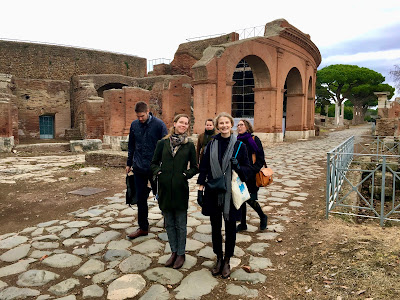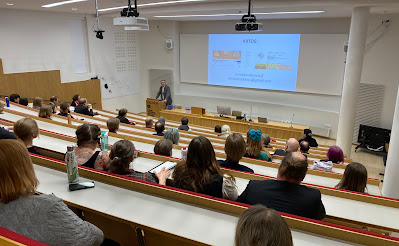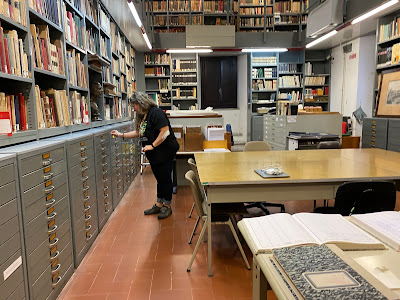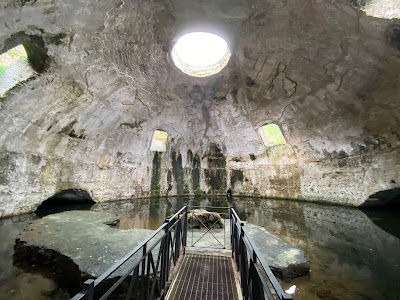Around this time in May 2020, I was returning from Rome to Finland after a very unusual spring during which the covid-19 pandemic threw the world into chaos. I was then working on a research project as part of a team at the Finnish Institute in Rome. When the pandemic began, our team decided to stay in Rome rather than interrupt our work and fly back to Finland. Memories of that extraordinary spring came vividly back to me when I was once again at the Institute in February, reading the diary entries our group had made in the institute’s guestbook (photos of the guestbook entries at the end of the article). I’d like to share some of my experiences from the spring five years ago.
 |
| Our research team (photo: Mikko Itälahti) |
In addition to myself, the team led by the institute’s director, Arja Karivieri, included Ville Kukkonen, Taneli Puputti, Maria Solin, Riikka Vuoksenmaa, and Anna Vuolanto. We arrived at Villa Lante, where the institute is situated, at the end of January with the intention of spending the entire spring in Rome working on a research project about the late antique and early medieval Ostia. Work began as planned, and we each started drafting our articles on Ostia.
 |
| We managed to visit Ostia once before the pandemic began |
 |
| Enjoying a picnic at Villa Doria Pamphilj park |
In February, life at the Institute went on as usual. We worked on our research and enjoyed our time in sunny Rome. At the end of February, our team traveled to a tourism fair in Florence to promote the Ostia exhibition that was open at the Vapriikki Museum in Tampere. We had already heard news of a new virus that had been detected in Europe. During the fair weekend, we started receiving reports of cases in Northern Italy. Despite this, we spent a pleasant weekend in Florence, visiting local sights alongside the fair.
 |
| Queuing to enter the Palazzo Pitti in Florence |
It soon became clear that the new virus was developing into a full-blown epidemic. In early March, public events began to be canceled in Rome, and other precautionary measures were taken. We weren’t yet too worried and continued working at the institute, spending time in the city and eating out as usual. However, some residents at the institute decided to end their stay and return home at this point.
 |
Our disappointment at hearing that Filippo Coarelli’s lecture was canceled
(photo: Taneli Puputti) |
By the second week of March, it was evident that the pandemic was serious. In Northern Italy, the virus had spread widely, and movement restrictions were imposed in those regions. More and more airlines began canceling flights to and from Italy. My boyfriend still dared to fly to Rome for a visit on Monday, March 9, but on the same day we learned that his return flight with Finnair had been canceled. Luckily, he managed to book another return flight with a different airline later that week. We were able to explore Rome together for a couple of days before places—even churches—began closing their doors due to the pandemic.
 |
| On Tuesday, March 10, bars were still open in Rome |
Our team was urged to return to Finland, but after careful consideration, we decided to stay in Rome. Anna’s husband Mikko and their son Vilho also stayed with us at Villa Lante, as their family had planned to live in Rome from March to May. The institute’s director Arja and the caretaker Giovanni along with their spouses also lived at Villa Lante. Intern Magda Hukari remained at the institute’s dormitory on Via Falda and visited Villa Lante from time to time.
 |
| We often cooked meals together |
Looking back, staying in Rome might have been a reckless choice since we didn’t know how bad the situation could get. However, many of us had sublet our apartments in Finland for the spring, and returning to Finland wasn’t too appealing. We had prepared to spend the whole spring in Rome, and there was still meaningful work to do with our research at the institute. We also felt it was better to stay together at Villa Lante during the lockdown than being isolated alone in Finland.
 |
| The team hard at work |
Italy imposed numerous restrictions to contain the pandemic, which affected everyday life. One could only leave home for valid reasons—like going to the store, doctor, or pharmacy—and had to carry a paper form with personal information and the reason for going out. Early in the pandemic, three of our team went shopping together to buy groceries for the whole group, but police stopped them at Piazza Garibaldi and informed them that only one person at a time could go to the grocery store. Since we were so many at Villa Lante, it was impossible for one person to carry all the groceries, so we took turns and staggered our shopping trips.
 |
People queued outside the store with safe distances
and only a few were let in at a time |
At the time, the virus’s transmission methods weren’t fully understood, and there was little testing. We didn’t have a clear idea of what to do if someone showed symptoms. In mid-March, I started feeling unwell. We decided I should isolate from the others for a while. I moved temporarily to a research fellow’s room with a private bathroom and a kitchenette (the fellow had returned to Finland). Food was delivered to my door in plastic bags, and the others chatted with me from a safe distance. One seminar was even held with the others on the terrace below my window while I commented from behind the window. About a week later, we concluded that it was a false alarm, and I was able to rejoin the group.
 |
| I took part in a terrace seminar from the window of my room |
Most of our days were spent in ordinary routines. We did as much research as possible with the available materials, cooked together, celebrated birthdays, sat in the sun on the terrace, and watched movies and TV shows in the library. We ordered so much pizza that one delivery guy became a familiar face, greeting us cheerfully at the gate with pizza boxes in his arms. We were sad to tell him in May that we were flying home and would no longer order pizza from him.
 |
| We made tiramisu for Riikka’s birthday |
Regular walks were banned, but walking a dog or jogging near your home was allowed. Once, while out running, the police stopped me outside Villa Lante, surprised that I was jogging there on Gianicolo Hill. It took some time to convince them I actually lived in Villa Lante, a Renaissance villa. Later, I dared to run all the way down to the Tiber River. One day, I encountered a police patrol around a river bend and quickly turned back, sprinting through Trastevere’s alleys to get back to the institute.
 |
| Running along the deserted riverbanks |
To ease our homesickness and to get a break from Italian food, we ordered treats from Fazer, a Finnish food company. It took several weeks for the shipment to arrive, but eventually two large boxes full of chocolate, candy, licorice, cookies, muesli, and crispbread were delivered to the institute's gate. It was one of the highlights of the spring!
 |
| Treats from Fazer |
Even in the middle of a pandemic, we celebrated Easter and May Day. On Easter, we cooked and ate together on the director’s terrace. The institute treated us to traditional colomba cakes. We also hunted for chocolate eggs hidden by the Easter Bunny in the library.
 |
| Easter meal (photo: Arja Karivieri) |
We prepared for May Day by making Finnish sima (mead) and limoncello. At our celebration, we “capped” a statue of Amos Anderson on the Villa Lante loggia instead of the traditional Herman Liikanen statue, since we couldn’t leave the premises due to restrictions. Rumor has it some residents still snuck out towards the Acqua Paola fountain in the dead of night.
 |
| Ville placing a student cap on Amos |
 |
| May Day treats made together |
In May, restrictions in Italy eased somewhat. I could now legally run all the way to the Colosseum and witness the empty streets of central Rome. Restaurants, bars, and cafes were allowed to serve takeout. We picked up pizzas from Trastevere’s Ai Marmi and enjoyed drinks outside the San Calisto bar.
 |
| In Piazza San Calisto |
The pandemic disrupted our research, but we reviewed our article drafts in the final seminar in the second week of May. With the seminar the team’s stay at the institute was coming to an end. Return flights from Rome to Finland were scarce, and our first (and second?) bookings were quickly canceled. Eventually, we found Lufthansa flights to Frankfurt—where we would have to spend the night—and from there to Helsinki the next day. The return trip became a whole adventure in itself.
 |
| Final seminar approaching... |
 |
| Farewell dinner on the director’s terrace |
On Friday, May 15, we celebrated the end of our work period with a shared meal on the director’s terrace and said our goodbyes to the institute. On Saturday afternoon, we left Villa Lante for Fiumicino Airport. The airport was quiet, and we got through security smoothly. At the gate, passengers were screened with a thermometer, and unexpectedly, Anna was found to have a fever. The rest of us had already boarded the plane when we were informed she couldn’t fly. Anna had to return to the institute and she flew to Finland about a week later. Her husband Mikko and son Vilho traveled with the rest of the group to Frankfurt and from there to Helsinki.
 |
| Our hopeful team at Fiumicino Airport |
We had booked rooms at an airport hotel in Frankfurt for our overnight layover. But upon arrival, we were told we couldn’t leave the international terminal area. So we had to sleep on the terminal benches with only the belongings we had in our carry-ons. Thankfully, we found food and drinks at one kiosk that was open.
 |
Spending the night at Frankfurt Airport was
(hopefully) a once-in-a-lifetime experience |
After a poor night’s sleep, we continued our journey to Helsinki on Sunday afternoon. The entire trip from Rome had been full of uncertainty—would the flights be canceled at the last minute, would we be stopped somewhere, or would something else unexpected happen? With all the different restrictions in place in Italy and Germany, it was hard to keep track. It wasn’t until the Helsinki-bound plane took off that we could finally breathe a sigh of relief, knowing we were heading home.
 |
| Happily back in Helsinki! |
Guestbook entries from the research group (click images to enlarge):






























































